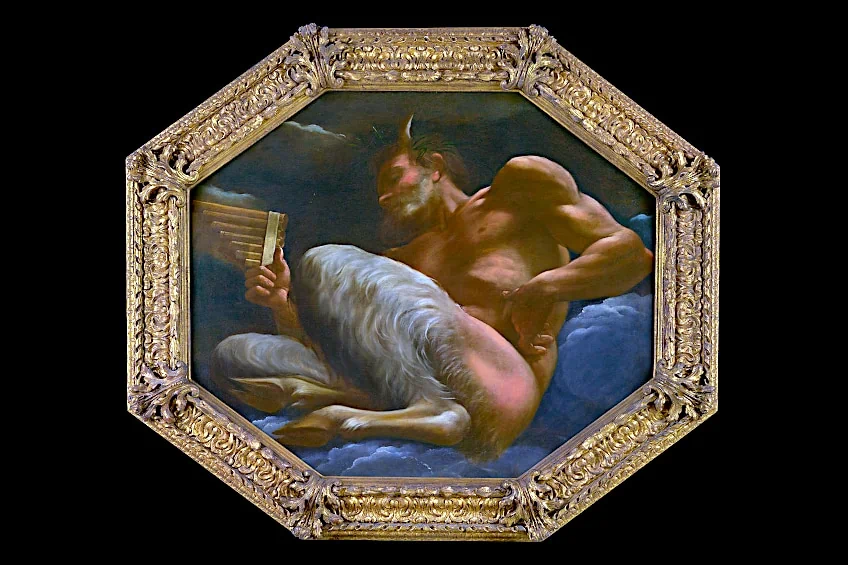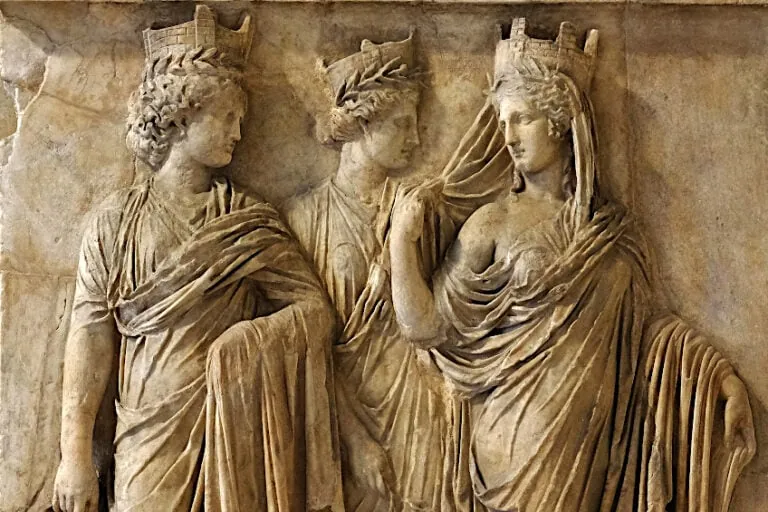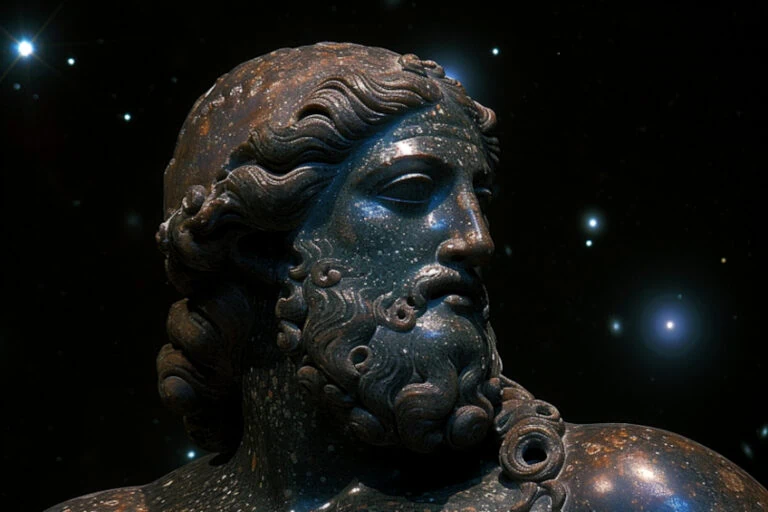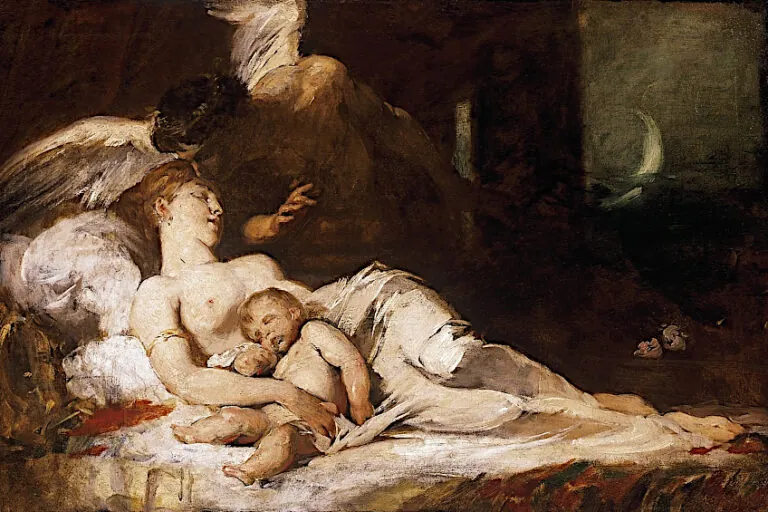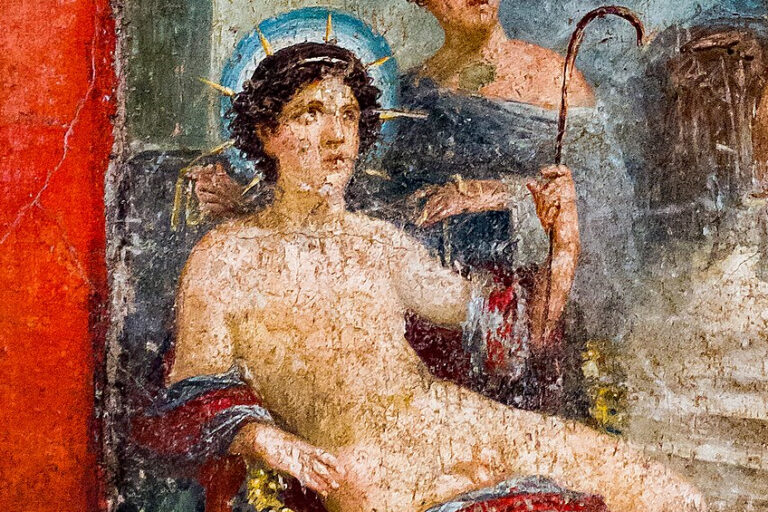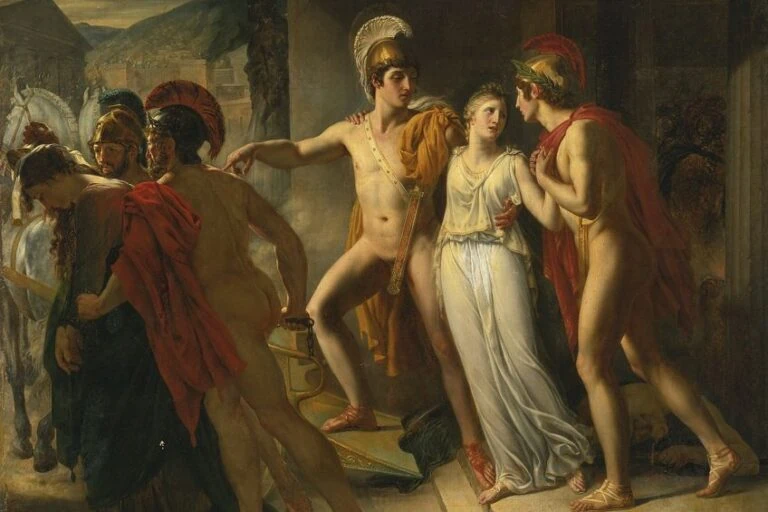Greek God Pan – Wild Guardian of Shepherds and Flocks
The Greek god Pan was not one of the major Olympian deities, yet he was still prominently featured in Greek mythology and became synonymous with paganism in Neo-Platonic and early Christian philosophy. What is Pan the god of, though, and what are Pan’s symbols? Pan is known as the god of the wild who watches over shepherds and their flocks, and his symbol is the flute or the pipes. Let us explore the Greek god Pan in greater detail below!
Exploring the Greek God of the Wild: Pan
| Name | Pan |
| Gender | Male |
| Symbols | Pan-flute or pipes |
| Personality | Energetic, wild, and unbridled creative force |
| Domains | The wild, shepherds, and flocks |
| Parents | Hermes and Dryops’ daughter; Zeus and Hybris or Callisto; Aether and Oenoe; Cronus and Rhea; Uranus and Gaia; Crathis and a nanny goat; Penelope and Hermes or all of her suitors |
| Spouse/Consort | Syrinx, Echo, and Pitys |
Known mostly as the Greek god of the wild, Pan was also associated with flocks, shepherds, and music, as well as being a close companion of the nymphs. With his origins in rural Arcadia, he is also known as the god of groves, fields, and forested glens, and is usually linked with sex; as a result, Pan is associated with spring and fertility and with the god with Faunus in Roman mythology.
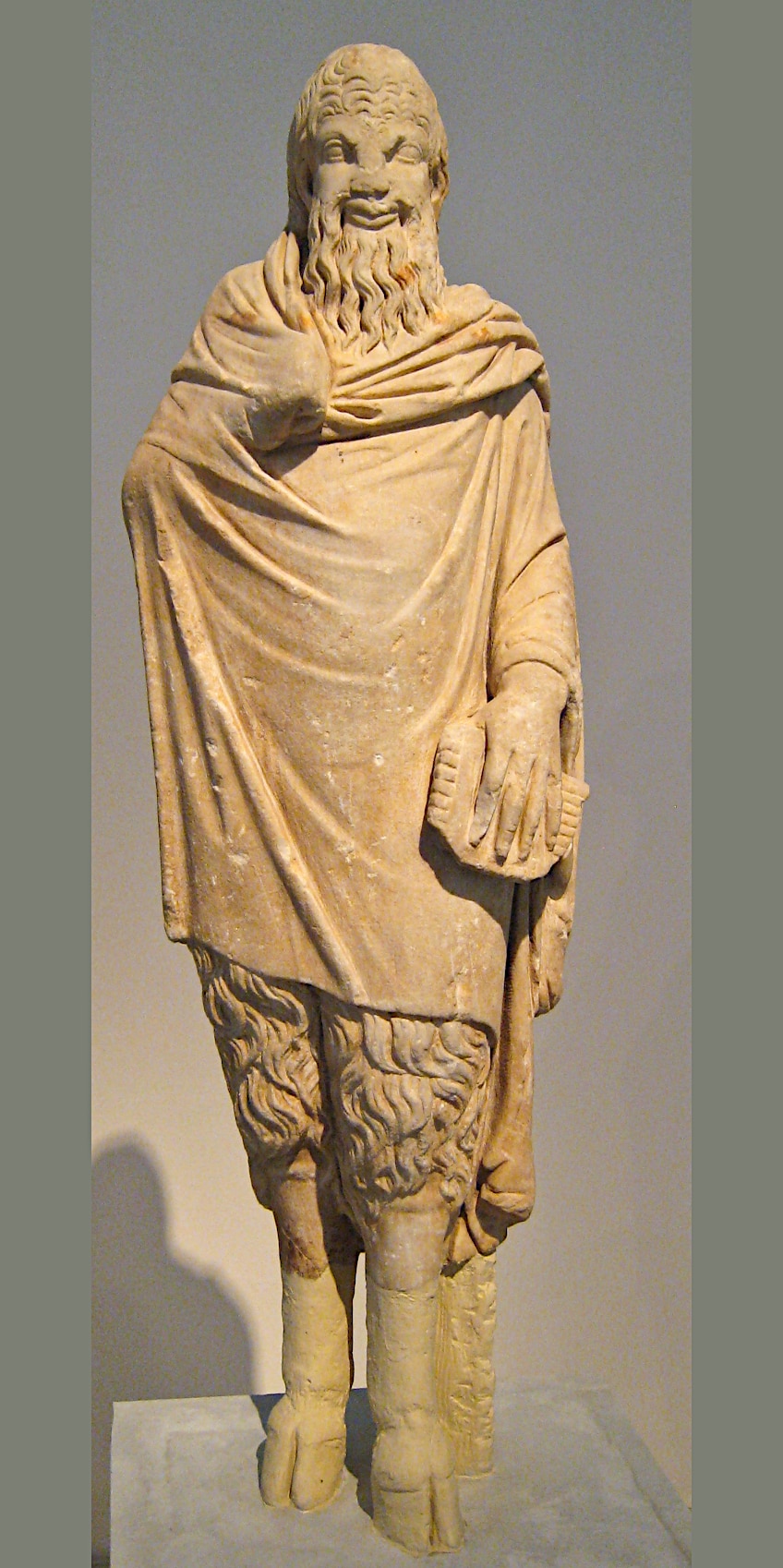 Copy of a 4th Century BCE Statue of Pan (1st Century CE); Sharon Mollerus, CC BY 2.0, via Wikimedia Commons
Copy of a 4th Century BCE Statue of Pan (1st Century CE); Sharon Mollerus, CC BY 2.0, via Wikimedia Commons
Background
Pan’s worship was closely considered to have originated and was closely associated with the mountainous region of Arcadia. In antiquity Arcadia was culturally distinct from the rest of Greece and the notion of a pastoral idyll is still described as “Arcadian”. If Arcadian hunters were dissatisfied with their prey, they would scourge the god’s statue.
The Greek god Pan, being a rustic deity, was worshiped in natural settings, mainly caverns or grottoes, such as the one on the northern slopes of Athens’ Acropolis. These are known as the Caves of Pan.
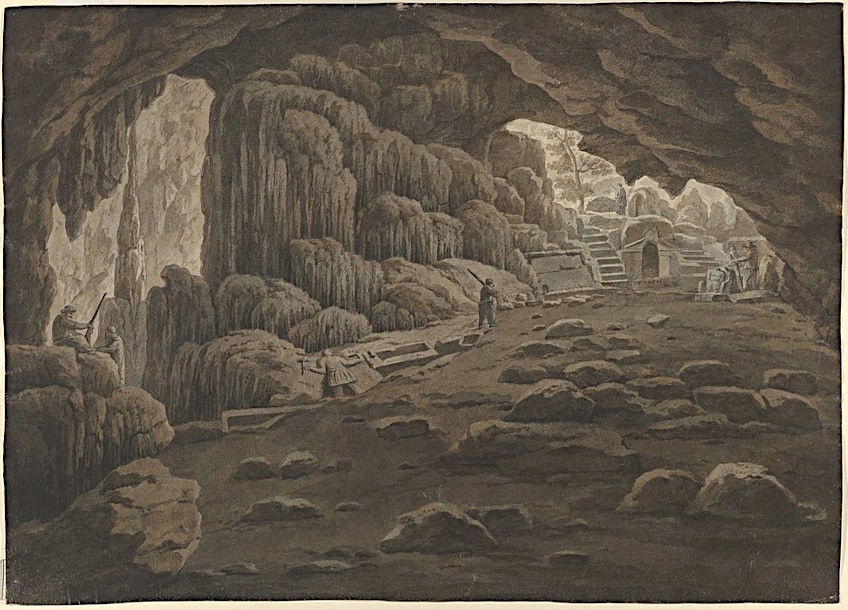 Cave of Pan, near Sunium, Greece by Simone Pomardi and Edward Dodwell (1805); Edward Dodwell, CC0, via Wikimedia Commons
Cave of Pan, near Sunium, Greece by Simone Pomardi and Edward Dodwell (1805); Edward Dodwell, CC0, via Wikimedia Commons
A few sacred precincts of Pan within urban areas include the remnants of Pan’s temple on the Neda River valley in southern Peloponnese and Pan’s temple at Apollonopolis Magna in ancient Egypt.
The Greek God Pan’s Parents
There are many different versions of Pan’s origin story. Some state that he is the offspring of Hermes and one of Dryops’ daughters or Odyseus’ faithful wife Penelope. Others state that he is the child of Zeus and either Hybris or Callisto. In other versions he is the child of the first couple Uranus and Gaia or their children Rhea and Cronus. In one version he is the result of a shepherd’s dalliance with a nanny goat and there are even versions of his origin story that claim that he is the offspring of Penelope and all the men who vied for her hand in Odysseus’ absence.
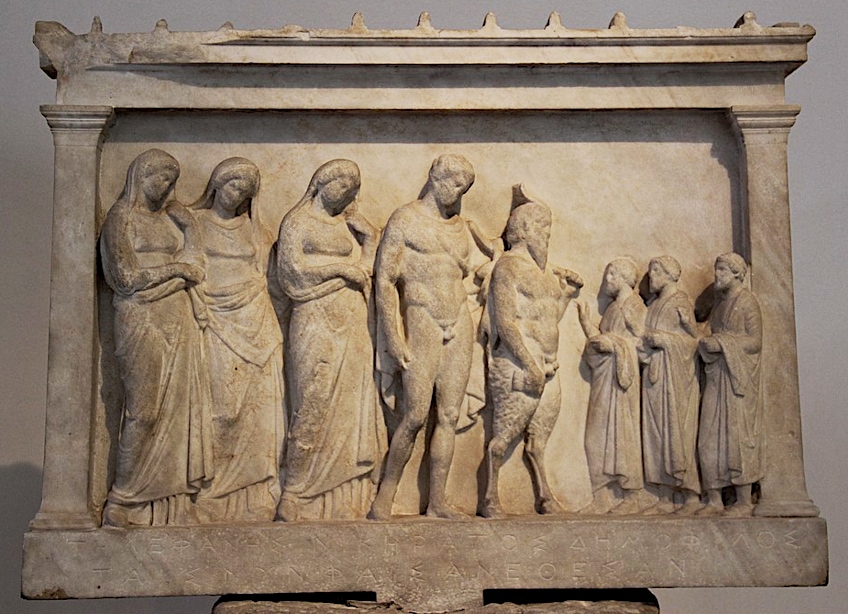 Votive relief showing Hermes, Pan and Three Nymphs greeting worshipers (c. 360 BCE); Gary Todd from Xinzheng, China, CC0, via Wikimedia Commons
Votive relief showing Hermes, Pan and Three Nymphs greeting worshipers (c. 360 BCE); Gary Todd from Xinzheng, China, CC0, via Wikimedia Commons
In the myth where he is the child of Hermes and the daughter of Dryops, Pan’s unique physiology (half boy, half goat) caused great mirth when his father presented him on Olympus. Causing some to speculate that he was called “Pan” which means “all” because he caused all of the gods to laugh at once.
In many myths, Pan seems to be older than the Olympian gods, assuming it is true that he handed Artemis her hunting hounds and imparted to Apollo the art of prophecy.
The Greek god Pan was the most ancient of the deities according to Egyptian chronology; but, based on the version in which Pan was the child of Penelope and Hermes, he could not have been born until the period of the Trojan War. According to the ancient historian Herodotus, that is when the Greeks first heard the name Pan.
Pan’s Role in Greek Mythology
Pan was widely regarded as the god of shepherds, flocks, and the natural world in which they lived. The Greek god Pan was connected with the pastoral lifestyle and was regarded as a protector of animals, ensuring their safety. Shepherds would invoke his presence to seek refuge from wolves and other threats.
Pan has also been associated with the wild and unbridled aspects of the natural world. He was said to live in woods, mountains, and caverns, reflecting the untamed and primeval elements of nature.
The Greek god Pan was connected with natural sounds such as leaf rustling, the wind blowing through trees, and streams pouring. Pan was also connected with the cycles of life and fertility. His presence was said to have contributed to an abundance of crops and animal reproduction. He was seen as a symbol of reproduction and was occasionally summoned to fertility and sexuality rites and celebrations.
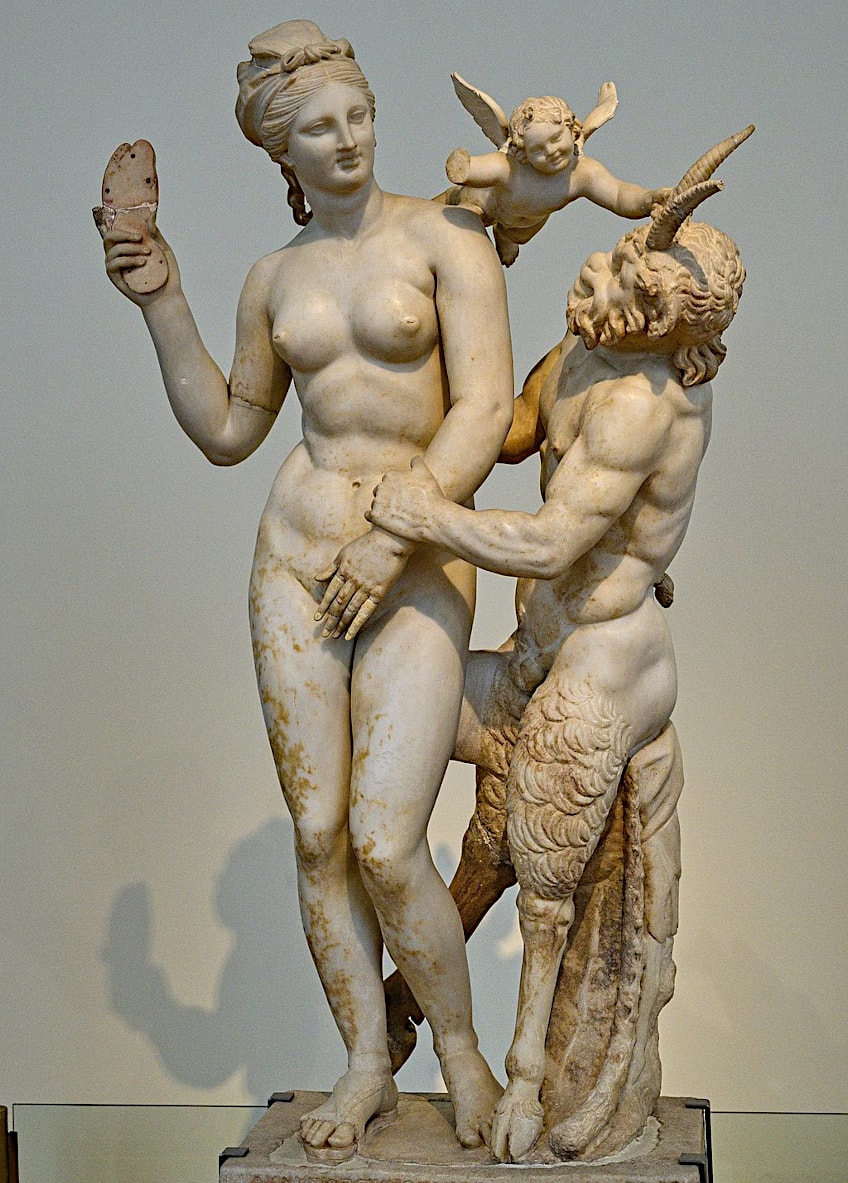 Aphrodite, Pan, and Eros (c. 100 BCE); Zde, CC BY-SA 4.0, via Wikimedia Commons
Aphrodite, Pan, and Eros (c. 100 BCE); Zde, CC BY-SA 4.0, via Wikimedia Commons
Pan was also cheeky and mischievous. He was a prankster, constantly pulling jokes on gods, mortals, and nymphs. His laughing, known as “pan’s pipes”, was said to produce sudden and inexplicable terror and anxiety, giving origin to the term “panic”.
The word Pan is also a Greek prefix that means “all”, and the Greek god Pan may have been a far more powerful, all-encompassing character at one point. In lesser-known myths, he is associated with the sea god called Haliplanktos, a healer of plagues through remedies given in dreams, and an oracle god. These numerous characteristics point to ancient proto-Indo-European roots. Some of these characteristics, like his sea-god appearance, even perplexed Classical Greek authors, implying that his origin legend was so old that it had been lost to time by the 5th Century BCE.
Personality and Attributes of Pan
Pan possessed goat-like lower limbs, complete with hooves. These legs enabled him to travel quickly and overcome difficult terrain. Pan was depicted with a pair of curving goat horns on his head. The horns represented his connection to the animal kingdom and nature. He was often represented with a hairy body as well as a beard. This accentuated his wild and primitive personality.
The Greek god Pan was often depicted carrying or playing the pan flute, also known as the syrinx.
It was a musical instrument constructed of intertwined reeds or pipes. Pan uses the pan flute to create captivating and beautiful melodies. Pan was sometimes represented with pointed, elf-like ears, emphasizing his connection to nature and its ethereal qualities.
 Copy of Heliodoros of Rhodes’ Pan teaching Daphnis to play the Flute (2nd Century CE); Museo nazionale romano di palazzo Altemps, Public domain, via Wikimedia Commons
Copy of Heliodoros of Rhodes’ Pan teaching Daphnis to play the Flute (2nd Century CE); Museo nazionale romano di palazzo Altemps, Public domain, via Wikimedia Commons
Personality
Pan had a reputation for his impish and playful disposition, and his pranks typically entailed unexpected and startling entrances, causing surprise and confusion. Pan’s mischievous antics gave his persona a feeling of unpredictability. Pan had a strong affinity towards the natural world. He was especially connected with wild, untamed locations like woods, mountains, and caverns.
Pan’s love of nature extended to animals, particularly goats since he was frequently depicted tending herds or surrounded by them. He was enthralled by the natural world’s sights, noises, and rhythms.
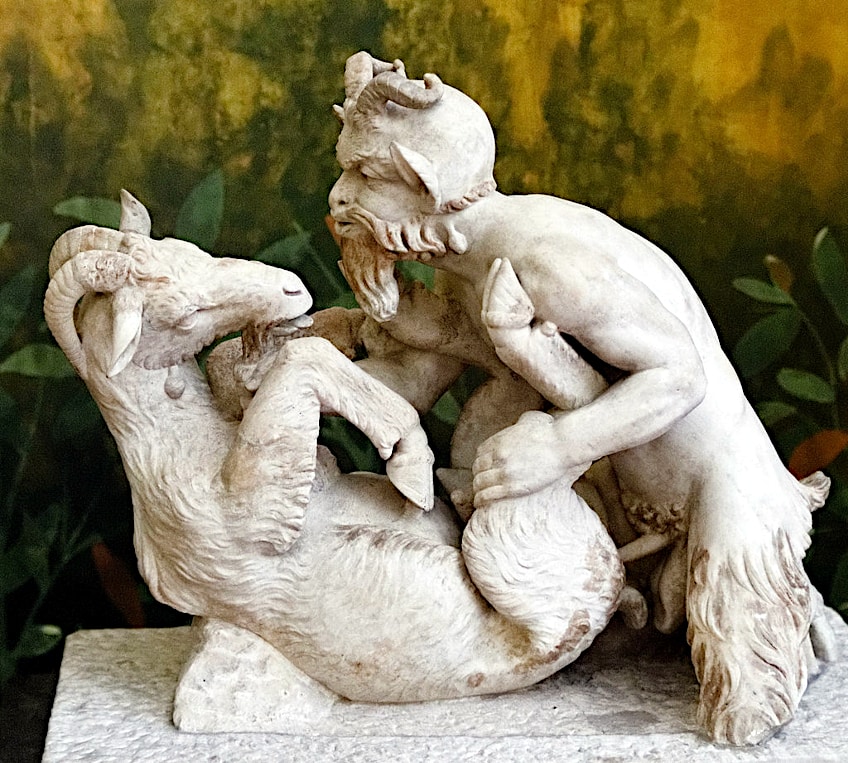 Pan Copulating with a She-Goat (c. 79 CE); Naples National Archaeological Museum, CC BY 2.5, via Wikimedia Commons
Pan Copulating with a She-Goat (c. 79 CE); Naples National Archaeological Museum, CC BY 2.5, via Wikimedia Commons
Pan was revered as a protector, and his fiery disposition can be observed in his willingness to defend his territory and those under his care from any dangers or injury. Pan’s music was considered to have a captivating and fascinating character that could either calm or elicit strong emotions. His musical aptitude represented his originality and ability to delve into the natural world’s harmonies. His seductive personality was frequently shown through his pursuit of nymphs. Pan’s quest for love and desire exemplified the primal and intuitive sides of human nature.
In a split second, his playful side could become quite dark. He had the ability to provoke ‘panic,’ a senseless terror or anger, under the command of the goddess Rhea.
It was believed that his presence caused men to feel anxious as they passed through the dark, lonely woods. And he wasn’t afraid to rip people apart sometimes. His biggest strengths – he’s lustful and an accomplished musician – are also his biggest flaws – he’s sexually ravenous and enjoys loud music, and likes loud, chaotic sounds in general.
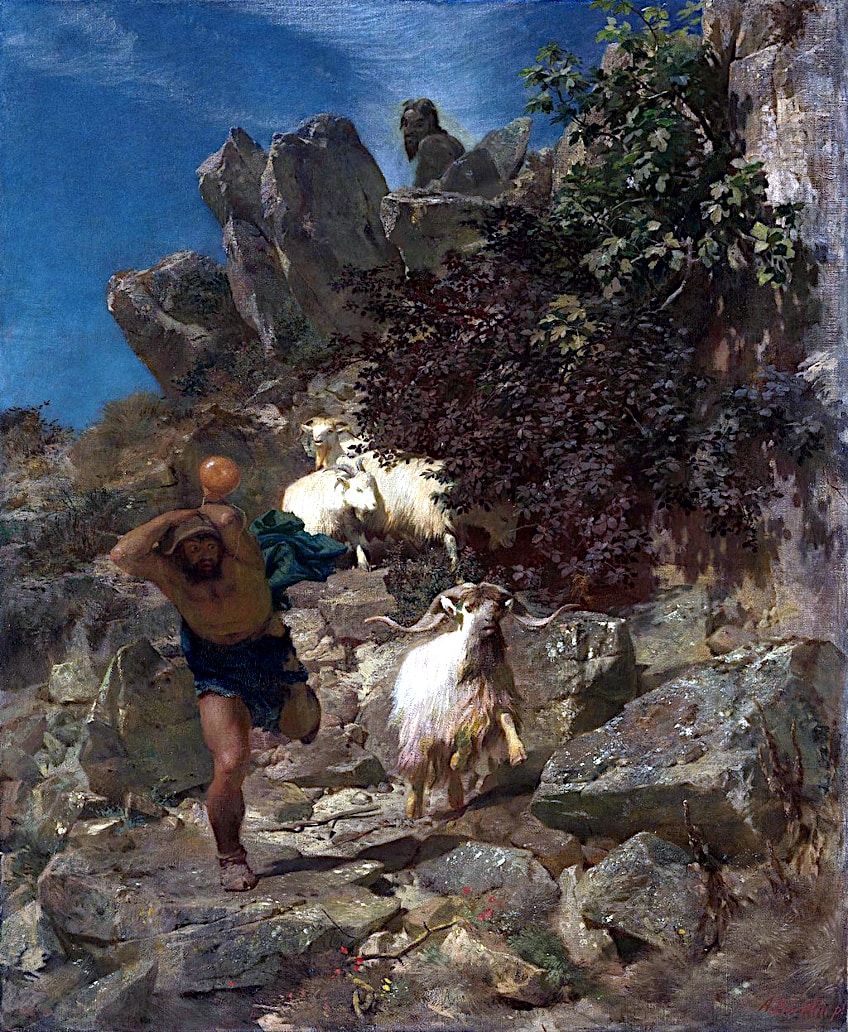 Pan Terrifies a Shepherd by Arnold Böcklin (1860); Arnold Böcklin, Public domain, via Wikimedia Commons
Pan Terrifies a Shepherd by Arnold Böcklin (1860); Arnold Böcklin, Public domain, via Wikimedia Commons
Pan’s Symbols
Pan’s symbols are the pan flute and the goat. One of Pan’s most famous stories concerns the origin of his pan flute, which was made from lengths of hollow reed. Syrinx was an Arcadian wood nymph and a child of Ladon, the river god. Pan encountered her on her way back from the hunt one day. The nymph tried to run away, not pausing to listen to his alluring compliments. He chased her down Mount Lycaeum until she was found by her sisters, who transformed her into a reed.
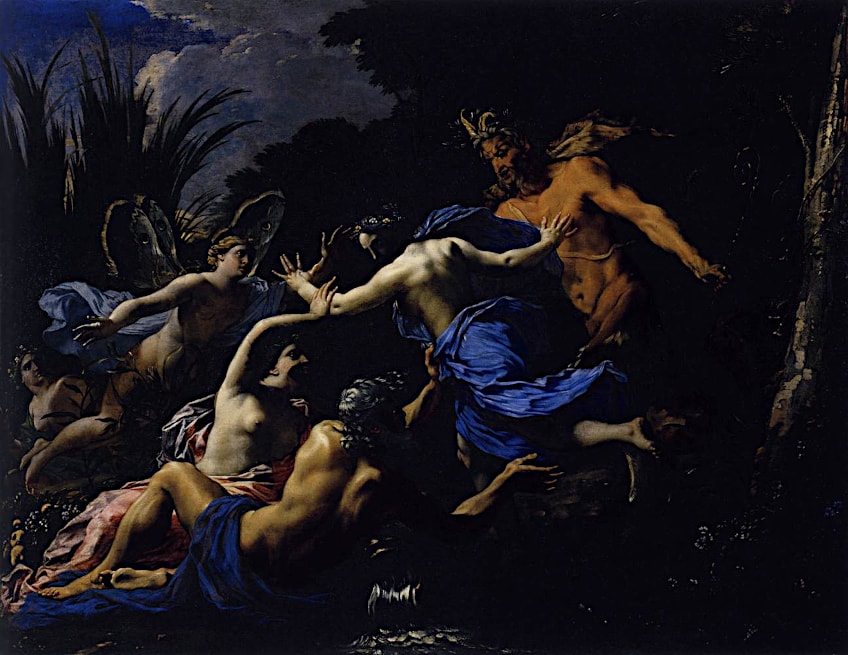 Pan and Syrinx by Michel Dorigny (1657); Michel Dorigny, Public domain, via Wikimedia Commons
Pan and Syrinx by Michel Dorigny (1657); Michel Dorigny, Public domain, via Wikimedia Commons
A sorrowful song could be heard when the air blew through the reeds. Because the Greek god Pan couldn’t figure out which reed the nymph had been turned into, he took several of the reeds and cut them into seven pieces, then set them next to each other in gradually decreasing sizes, and created the musical instrument which he named after his beloved Syrinx. Pan was rarely ever seen without it from then on.
Pan’s sacred animal is the goat and he is so strongly associated with the animal that he takes on some of its characteristics, such as his goat’s hind legs and horns.
The Mythology of the Greek God of the Wild
Pan is renowned for his libido and often appears with a phallus. Diogenes of Sinope narrated a story about Pan acquiring masturbation from his father, Hermes, and spreading the behavior to shepherds. According to Greek mythology, Pan once deceived the moon goddess Selene with a sheep’s fleece and comforted Psyche when she was being persecuted by Aphrodite. Let’s find out what other myths the Greek god Pan is associated with.
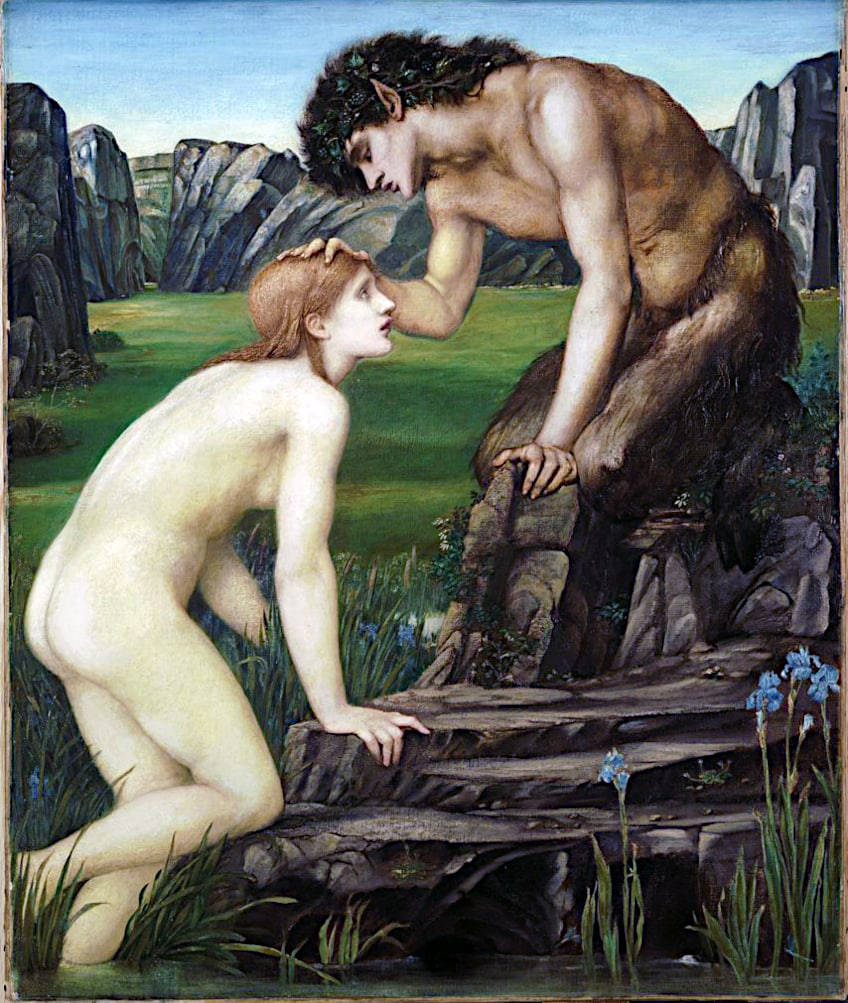 Pan and Psyche by Edward Burne-Jones (between 1872 and 1874); Edward Burne-Jones, Public domain, via Wikimedia Commons
Pan and Psyche by Edward Burne-Jones (between 1872 and 1874); Edward Burne-Jones, Public domain, via Wikimedia Commons
Pan and Midas
King Midas once overheard a disagreement between the gods Apollo and Pan, while strolling through the woods one day. Apollo was renowned for making music that was so wonderful that it could even heal an ill person who heard it. When Apollo’s musical skill came into question, he could react in cruel ways. “Without a doubt, I can play more proficiently on my flute than you can on your harp”, Pan said to Apollo during their argument.
To hear their argument more clearly, King Midas walked into the clearing where the gods were standing. When Apollo saw him, he remarked, “Let us have a competition, and let the noble King Midas decide who makes better music”.
Pan started by playing his flute. The music he performed was so lively and welcoming that the monarch couldn’t help but tap his foot. He was soon dancing around madly to the music. Even though the king grew dizzy and out of breath, he couldn’t stop dancing to Pan’s alluring tunes. Pan finally relented and ceased playing. It was now Apollo’s time to play the harp. The birds even stopped tweeting so they could listen when they heard the first beautiful melody start to play. The wind ceased blowing and every living thing stopped moving to hear his song.
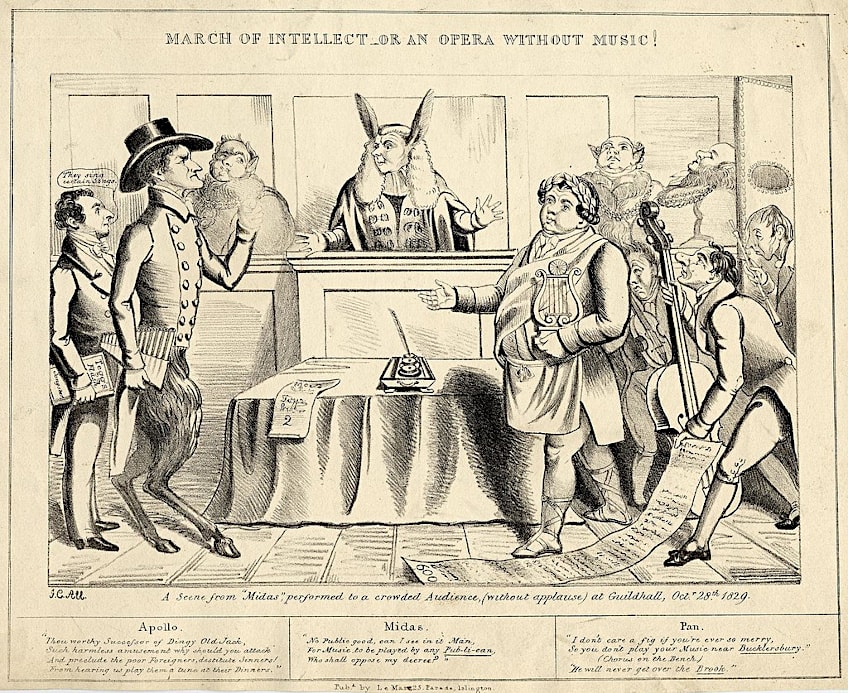 March of Intellect – or an opera without music! By an unknown artist (1829). In this satire the artist uses the myth of Midas to mock a court petition for a licence to play music in The Queen’s Arms tavern; British Museum, Public domain, via Wikimedia Commons
March of Intellect – or an opera without music! By an unknown artist (1829). In this satire the artist uses the myth of Midas to mock a court petition for a licence to play music in The Queen’s Arms tavern; British Museum, Public domain, via Wikimedia Commons
Apart from the music, the only sound was the king’s breathing. After five minutes, the entire woodland appeared to sigh collectively. “Pan’s music is undoubtedly the best”, announced the king. “You devlish little goat-god!” roared Apollo. “You don’t need those ears because you’re deaf to the sound of good music”, he stated to King Midas, adding. “you’ll have donkey ears from now on”. When the king reached up to feel his head, he touched donkey ears.
Midas tried to stay concealed in the woods for the remainder of his life, even having a special cap manufactured to conceal his ears.
Pan and Echo
The nymph Echo was known to be an excellent dancer and singer but loathed the love of men. This enraged the Greek god Pan who ordered his followers to murder her. Echo was broken into pieces and strewn across the land, and her voice now forever repeats the dying words of others. Pan and Echo had two children together in some versions of the story: Lynx and Lambe. In other versions of the tale, the god of the wild had fallen in love with Echo, but she despised any man’s love yet had fell hopelessly in love with Narcissus. When he ignored her for his own image she withered away until only her voice remained.
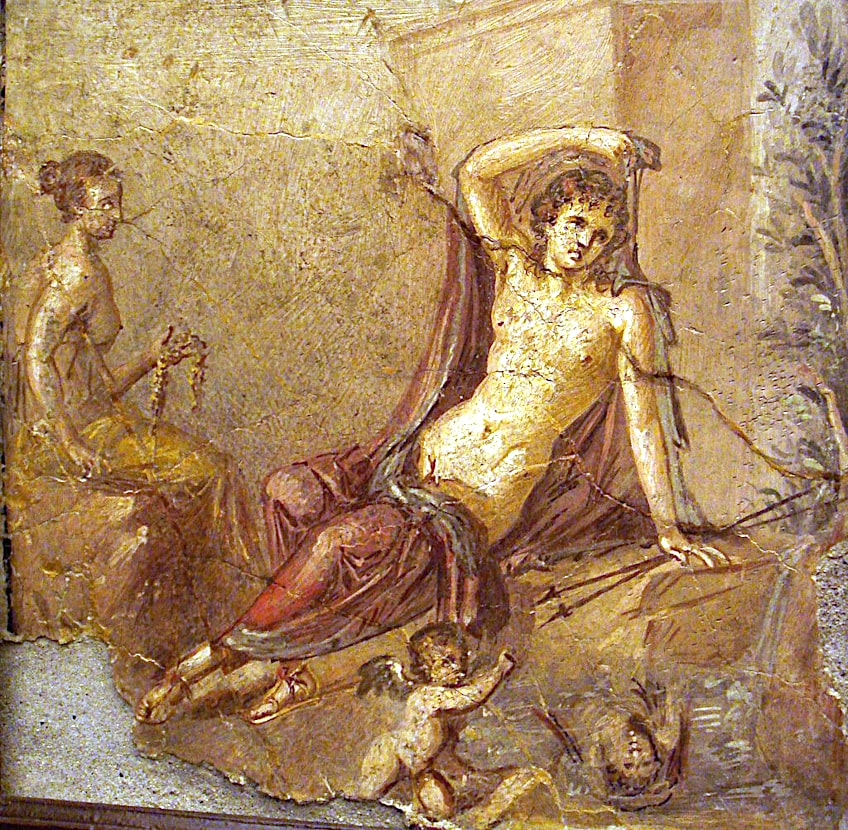 Fresco depicting Echo and Narcissus (45-79 CE); Stefano Bolognini, Attribution, via Wikimedia Commons
Fresco depicting Echo and Narcissus (45-79 CE); Stefano Bolognini, Attribution, via Wikimedia Commons
In another version of her myth, Echo was cursed by Hera so that she could no longer speak for herself but only repeat the words voiced by others.
Pan and the Titans
When the Titans, commanded by their great king Cronus, attempted to overthrow the Titans’ reign and claim themselves as the ultimate gods, they were met with immense opposition from the Olympians. The Titans were fearsome opponents because of their great strength.
The Greek god Pan played an important part in this battle. Pan had a horrifying scream that could induce terror and disorientation among people who heard it.
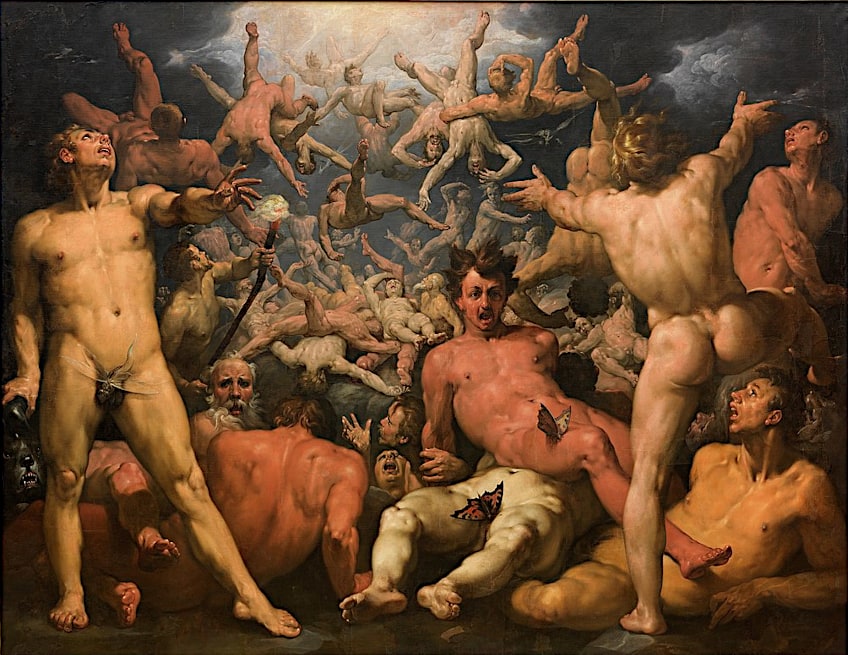 The Fall of the Titans by Cornelis van Haarlem (from 1588 to 1590); Cornelis van Haarlem, Public domain, via Wikimedia Commons
The Fall of the Titans by Cornelis van Haarlem (from 1588 to 1590); Cornelis van Haarlem, Public domain, via Wikimedia Commons
Pan’s chaotic and unpredictable personality made him a perfect ally for the Olympians. Pan entered the fray as the Titans and Olympians were battling it out, releasing his phenomenal scream against the Titans. The earth-shattering boom echoed over the battlefield, frightening the Titans. Pan’s scream caused immense confusion and shattered the Titans’ formation, allowing the Olympian gods to gain the upper hand. Pan’s participation in battle helped tip the scales in the Olympian gods’ favor.
The Death of Pan
The Greek philosopher Plutarch wrote of a legend said to have occurred during Tiberius’ reign. A mariner named Thamus heard a voice cry out to him while sailing to Italy via the Greek island of Paxi. “Thamus, are you there? When you get to Palodes, make sure to announce the death of the great deity Pan”. Thamus did so, and the announcement was met with lamentation from the shores.
In recent times, G. K. Chesterton has emphasized and expanded on the meaning of Pan’s “death”, claiming that with it came the arrival of Christian theology.
Chesterton stated that it was believed that Pan died because Jesus Christ was born. “In another way, it is as true that mankind knew Christ was born since Pan was already dead. The fading realm of mankind’s mythology created a vacancy that would have choked like a vacuum if not replaced with theology”. It was read in two ways: literally as historical reality, and metaphorically as the demise of the old order with the arrival of the new. Neoplatonist and Christian philosophers had made Pan the all-embracing symbol of paganism, so the rumors of his death predicted the demise of the entire culture and belief system associated with him.
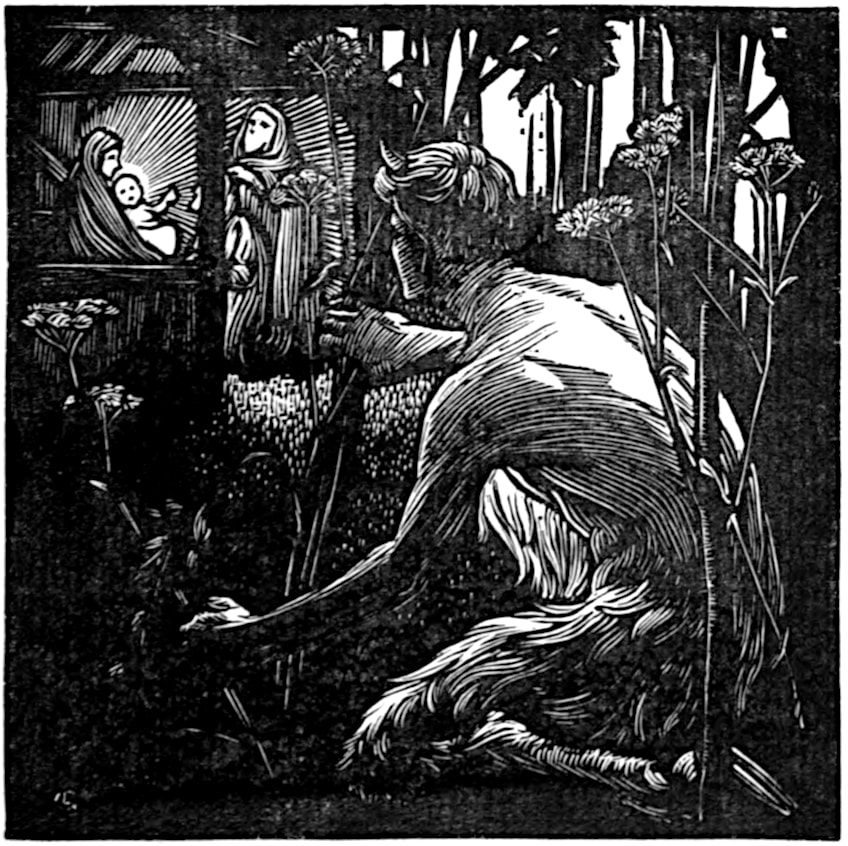 The Death of Pan by Louise Glazier (1903); Louise Glazier, Public domain, via Wikimedia Commons
The Death of Pan by Louise Glazier (1903); Louise Glazier, Public domain, via Wikimedia Commons
Other scholars have proposed a different rationale for this legend in more recent times. For instance, Robert Graves stated that the sailors misinterpreted the ritualistic cries of Tammuz worshipers, “All-great Tammuz is dead!” as an announcement aimed at an Egyptian sailor called “Thamus”.
Tammuz was a Mesopotamian god, who like Persephone, spent half the year in the underworld, so rituals where worshipers lamented his death were celebrated annually. As a fertility god, Tammuz was also associated with aspects of Pan, hence the confusion.
Literary Influence
Liberal intellectuals rekindled their interest in Pan in the late 18th century. In his Discourse on the Worship of Priapus (1786), Richard Payne Knight regarded Pan as a metaphor for creation manifested via sexuality. The Greek god Pan is depicted pouring water on the organ of creation; that is, the productive element energizing its dynamic creative power.
Endymion (1818) by John Keats begins with a celebration devoted to Pan, during which a stanzaic hymn is performed in his honor. Keats’ portrayal of Pan’s actions is heavily influenced by Elizabethan poets.
The god of the wild, the tutelary deity of shepherds, has long been allegorized on numerous levels, from Jesus to Universal Nature; thus, he becomes the emblem of the passionate imagination, of supra-mortal wisdom, according to Douglas Bush. Pan became an iconic character in art and literature in the late 19th century. According to Patricia Merivale, there was an astonishing revival of fascination with the concept of Pan between 1890 and 1926. He features in novels, poetry, and children’s stories.
In the tale of Peter Pan, the protagonist represents a golden period of pre-civilization in the imaginations of young children, before enculturation and schooling, as well as in the natural world free of human influence.
Peter Pan’s persona is both endearing and self-serving, highlighting our cultural ambiguity over whether human inclinations are inherent and good or uncivilized and evil. J. M. Barrie portrays Peter as half animalistic and partly human and makes use of this approach to investigate many aspects of human and animal behavior in the Peter Pan novels. Tom Robbins’ novel Jitterbug Perfume mixes together many narratives and covers multiple time periods. It delves into issues such as immortality, the pursuit of everlasting youth, and the power of fragrance.
 Peter Pan in Kensington Gardens: from the little white bird by Arthur Rackham (1912); J. M. Barrie, Public domain, via Wikimedia Commons
Peter Pan in Kensington Gardens: from the little white bird by Arthur Rackham (1912); J. M. Barrie, Public domain, via Wikimedia Commons
Pan is presented as a mischievous and potent god throughout the novel, symbolizing the intuitive side of human nature. Pan’s persona in the story is linked to Alobar, an ancient ruler seeking the secrets of immortality. Pan is Alobar’s mentor and source of wisdom, pushing him to appreciate life’s sensuous joys while rejecting conventional traditions that limit individual freedom and energy.
Pan’s presence serves as a juxtaposition to the sterilized and materialistic society represented in the story’s setting. The work praises the influence of sexuality, nature, and the quest for pleasure as important components of human existence through the character of Pan.
Revival of Worship
A group of 18th-century nobles organized an annual parade devoted to Pan in Painswick, Gloucestershire, during which a sculpture of the god was raised aloft and people yelled “Highgates! Highgates!”. They also built temples and pavilions for the Greek god Pan in his garden, as well as a “Pan’s lodge” overlooking Painswick Valley. This tradition faded out in the 1830s but was recreated in 1885 by the newly appointed vicar, W. H. Seddon, who incorrectly thought its origins were ancient.
Victor Neuburg and Aleister Crowley, renowned occultists, constructed an altar to the god of the wild on a mountain in Algeria, where they carried out a magical rite to invoke the deity.
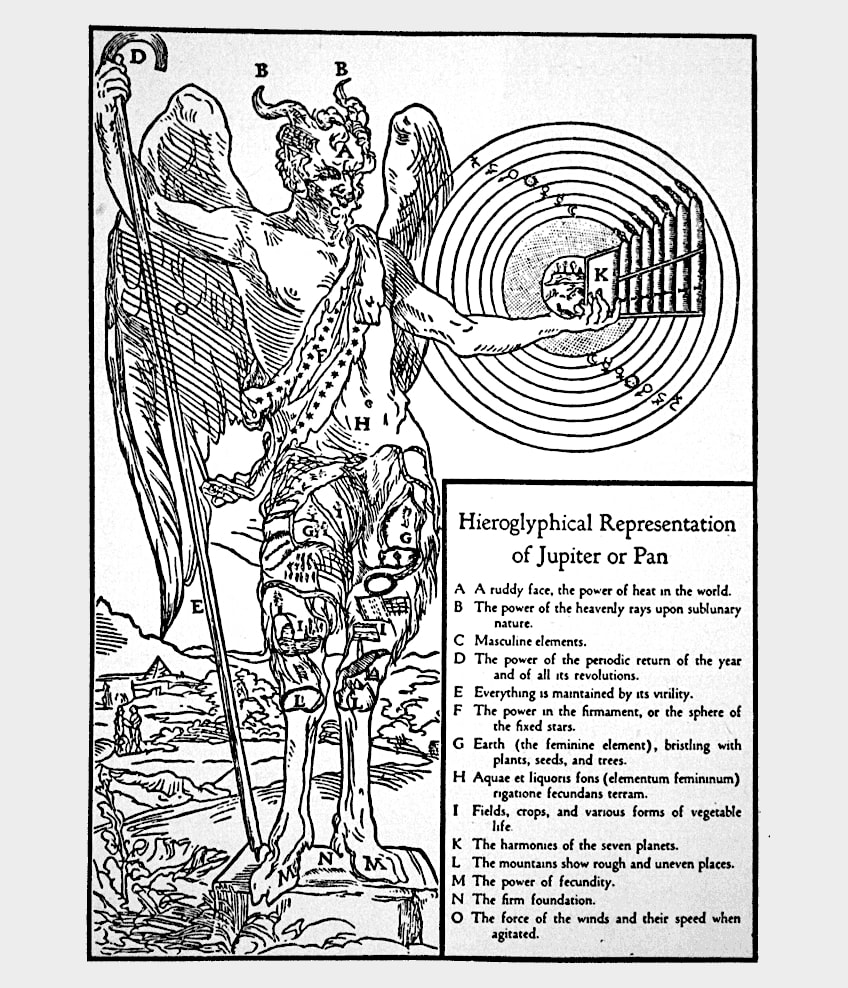 Heiroglyphical Representation of Jupiter or Pan from Athanasius Kircher’s Œdipus Ægyptiacus (1928); Athanasius Kircher, Public domain, via Wikimedia Commons
Heiroglyphical Representation of Jupiter or Pan from Athanasius Kircher’s Œdipus Ægyptiacus (1928); Athanasius Kircher, Public domain, via Wikimedia Commons
Pan “pushes back the very last veil, exposing the child Horus, who symbolizes humanity’s immortal and divine element,” according to Crowley’s ritual drama The Rites of Eleusis. Margaret Murray, an Egyptologist, released The God of the Witches (1933), in which she proposed that Pan was only one manifestation of a horned deity worshiped by a witch cult across Europe. This hypothesis impacted the Neopagan concept of the Horned God as a masculine sexuality and virility archetype.
The archetype of the Horned God, as portrayed by Hindu Pashupati, Celtic Cernunnos, and Greek Pan, is very prominent in Wicca.
Association With Satan
According to certain Christian beliefs and historical ties, Pan is associated with Satan. Throughout the early Christian period, as the new faith expanded over Europe, Christian missionaries regularly encountered native pagan beliefs and gods. To establish supremacy and prevent the worship of these pagan divinities, some early Christian scholars attempted to associate them with sin and Satan.
Pan’s relationship with the wilderness, passion, and, at times, terror made him an ideal target for demonization.
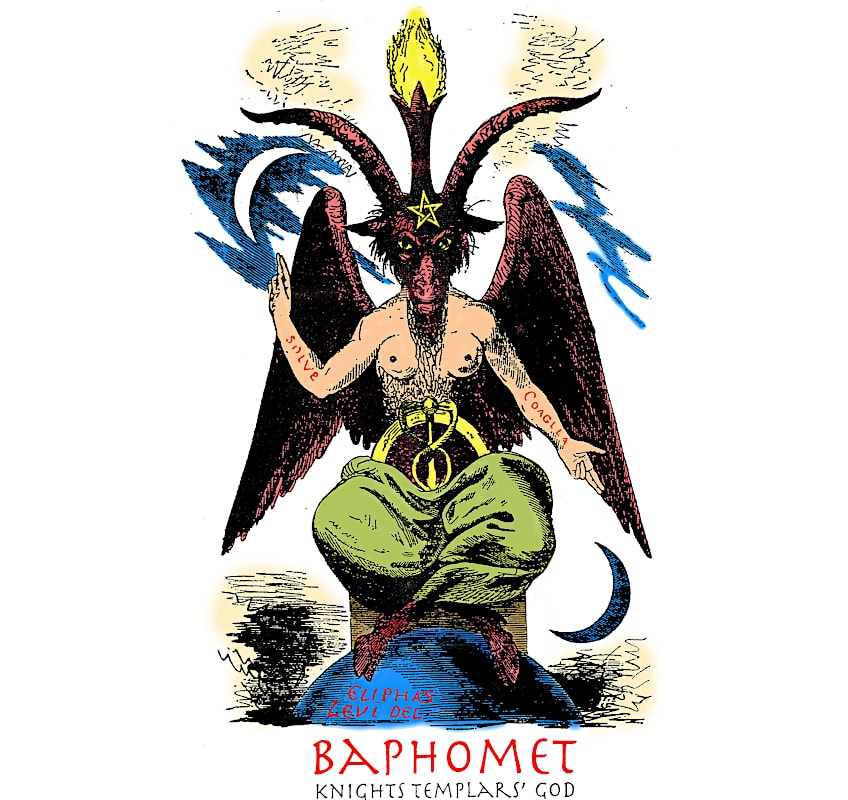 Eliphas Levi’s 1854 depiction of the Satanic figure Baphomet included distinctly Pan-like attributes; Art by Eliphas Levi. Color by David B. Pearson, Public domain, via Wikimedia Commons
Eliphas Levi’s 1854 depiction of the Satanic figure Baphomet included distinctly Pan-like attributes; Art by Eliphas Levi. Color by David B. Pearson, Public domain, via Wikimedia Commons
The depiction of Pan as a symbol of uncontrollable and primitive passions corresponded to the Christian view of Satan as the tempter who enticed people into wicked activity. As a result, certain Christian texts and artistic depictions of Pan began to portray him as a demonic character, connecting him with Satan.
The Greek God Pan Through the Ages
Pan was beloved and revered as a god connected with nature, fertility, and music throughout the Hellenistic and Roman periods. His worship extended throughout the Mediterranean, and he appeared often in art and featured in religious rituals. As Christianity began to dominate Europe, the image of Pan, like other pagan deities, saw a shift in perspective. Early Christian theologians attempted to vilify pagan gods, especially Pan who was depicted as a demonic figure, and his wildness and sexuality were reviled.
Pan witnessed a revival in prominence as a topic of art and literary works with the renewal of interest in ancient mythology during the Renaissance.
In numerous sculptures, artworks, and writings, he was portrayed as a half-human, half-goat beast. Pan became a symbol of the untamed outdoors over the years. His relationship with rural life, shepherds, and the balance between humans and nature became widely recognized. Pan’s visage has been used in literature and art to depict nature’s awe-inspiring majesty and beauty.
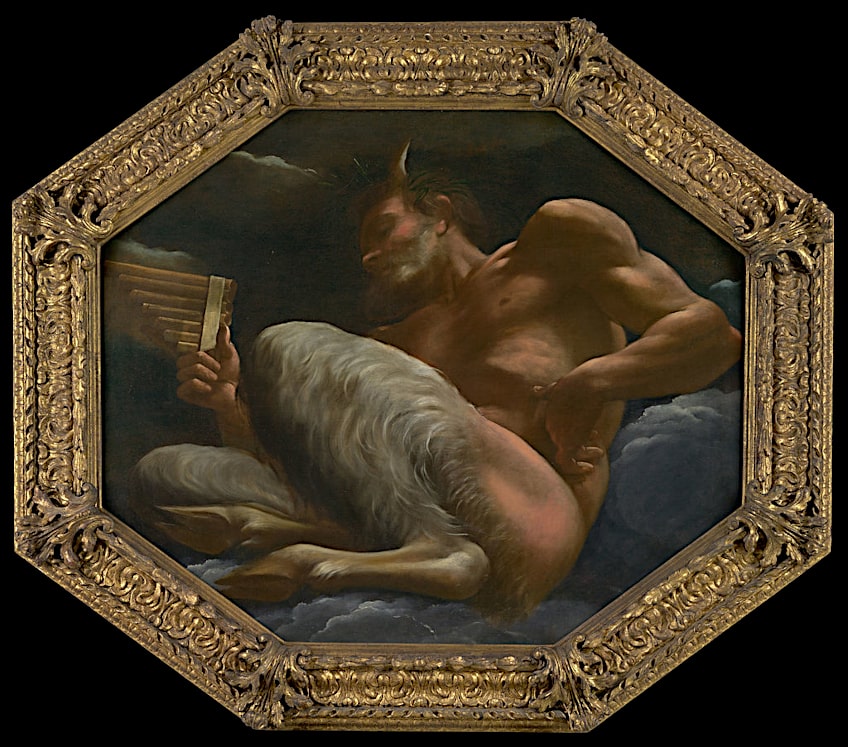 Pan by Annibale Carracci (c. 1592); Annibale Carracci, Public domain, via Wikimedia Commons
Pan by Annibale Carracci (c. 1592); Annibale Carracci, Public domain, via Wikimedia Commons
Pan’s persona and concepts are used in contemporary art as a way of expressing primordial desires, freedom, and sexuality. Pan is sometimes regarded as a god or recognized as an archetypal figure connected with nature, fertility, and energy among neopagan and spiritual groups. Some modern pagan activities, rituals, and celebrations use Pan as a depiction of natural energies and the divinity inside nature.
The Greek god Pan was associated with forest woods, shepherds, and flocks. Pan was a precocious infant born in Arcadia to a daughter of Dryad and Hermes, with goat’s hooves and a horned head that thrilled gods but alarmed mankind. Nymphs weren’t thrilled with his appearance, and as much as Pan adored them, they nearly never reciprocated. Syrinx, one of them, decided to be converted into marsh reeds in order to avoid Pan’s advances. The god of the wild chopped the reeds and linked them in descending order, resulting in the first set of panpipes. Pan was hardly seen without his musical instrument since then.
Frequently Asked Questions
What Is Pan the God of in Greek Mythology?
Pan represents nature’s untamed powers and is connected with mountains, woods, caverns, and other wild locations. He represents the wild and primeval elements of nature. Shepherds and their flocks are believed to be protected by the Greek god Pan. He was said to keep an eye on the health and fertility of animals, assuring their safety and abundance. Pan is also associated with music, namely pan flute playing. He is portrayed as a cheerful and optimistic deity who enjoys music, dancing, and festivity. The god of the wild is associated with fertility, representing nature’s reproductive abilities. The Greek god Pan’s presence often has to do with wildlife, plants, and human vigor and growth.
What Are Pan’s Symbols?
The pan pipes are a classic musical instrument linked with Pan. They are made up of a succession of reeds or pipes of varied lengths that are tied together. Pan is often seen playing the pan pipes, representing his link to rural music and the peaceful sounds of nature. Pan’s relationship with goats is notable as a half-human, half-goat creature. Goats are sacred to Pan and often appear beside him in art and folklore. The goat represents his relationship with nature, wildness, and fertility. Pan is sometimes pictured wearing a wreath or crown composed of pine branches or leaves. The pine represents his affinity for woods and the outdoors. Pan is sometimes represented as a fawn or a satyr in various artistic portrayals.

I am deeply passionate about history and am constantly fascinated by the rich and complex stories of the past. As the editor-in-chief of learning-history.com, I have the opportunity to share this passion with a wide audience through the creation and distribution of engaging and informative content about historical events, persons, and cultures. Whether it’s through writing articles and blog posts or creating videos or podcasts, I strive to bring the past to life in a way that is both accurate and enjoyable. My expertise in history, combined with my strong writing and communication skills, allows me to effectively communicate complex historical concepts and make them accessible and interesting to a wide range of readers. I am truly grateful for the opportunity to share my love of history with others through my work on learning-history.com.

